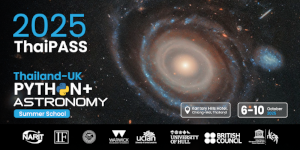All files covered at ThaiPASS are on the ThaiPASS'25 GitHub.
###################################
Pre-ThaiPASS exercise and questionnaire
Basic Python tutorials are now on the ThaiPASS GitHub. There are also good beginner courses in Thai on ThaiMooc.
All participants must submit work for the Pre-ThaiPASS exercise.
Homework questions are here (ipynb files on GitHub).
Submission links to Google Forms (Google account required):
a) The Sun
b) Exoplanets
c) Galaxies
Deadline: 15 September 2025, 12noon Thailand time.
Pre-ThaiPASS questionnaire: Before you arrive at ThaiPASS, please complete this questionnaire so we can better understand your background and future goals.
Summary of activities
|
|
Group 1 |
Group 2 |
Group 3 |
|
Mon |
The Sun |
Galaxies |
Exoplanets |
|
Tue |
Galaxies |
Exoplanets |
The Sun |
|
Wed |
Supermassive Black Holes / Excursion |
||
|
Thu |
Exoplanets |
The Sun |
Galaxies |
|
Fri |
University & Career Day / Feedback / Lunch and departure |
||
Slides and model solutions will be available on the ThaiPASS'25 GitHub page.
Detailed programme
EXOPLANETS: SEARCHING FOR NEW WORLDS
Dimitris Stamatellos and George Blaylock-Squibbs (University of Central Lancashire)
Abstract: We will introduce students to exoplanet detection methods and discuss planet formation theories. Topics include:
- Exoplanet detection methods (direct imaging, transits, radial velocities, microlensing)
- Properties of observed exoplanets
- Requirements for a planet to be habitable
- Planet-formation theories
- Recent results from the James Webb Space Telescope.
Students will work with exoplanet transit data from the Kepler Mission database. Students will plot transit curves and use them to determine whether a planet is in the habitable zone. Students will learn about the main exoplanet detection methods and basic planet formation theories. They will understand more deeply our quest for finding new exoplanets and traces of life outside our Solar System.
THE MARVELS OF OUR SUN
Lauren Doyle and Cam Heather (University of Warwick)
Abstract: We will explore solar physics concepts and how these are applied to other stars. Topics include:
- Big questions in solar physics (e.g. coronal heating)
- Solar and magnetic cycles
- Sunspots, solar flares, coronal mass ejections and prominences
- What does stellar activity look like on other stars and how can we observe it?
We will use real solar and stellar data from the Solar Dynamics Observatory (SDO) and Transiting Exoplanet Survey Satellite (TESS). This will involve using Python to manipulate images of the Sun to explore what is happening on its surface and investigating stellar activity in other stars. Students will gain a deeper understanding of solar and stellar
activity and how it can affect planets both in our Solar System and beyond.
EXPLORING GALAXIES WITH MACHINE LEARNING & AI
Claire Cashmore and Georgia Lowes (University of Hull)
Abstract: We will explore galactic and extragalactic astronomy, from large-scale structure of the Universe down to small-scale physics that shape each galaxy. Vast amounts of data are being produced by observations and simulations, and manually analysing Big Data is becoming impossible without machine learning and AI - which will be explored here.
Topics include:
- Galaxies as cosmic building blocks
- Galaxy morphology and evolution
- Overview of machine learning techniques
We will use machine learning (e.g. convolutional neural networks) for galaxy classification. Students will compare real and simulated images of galaxies (e.g. from Illustris) and classify them by type. Students will learn about the physical processes responsible for producing different types of galaxies.
Wednesday session (for all groups):
HOW THE GIANTS GROW: Tracing the evolution of supermassive black holes
Krittapas Chanchaiworawit (National Astronomy Research Institute of Thailand)
Abstract: Actively accreting supermassive black holes grow rapidly by eating up their surrounding material. They also emit strongly in all frequencies of electromagnetic spectrum. The mass and growth-rate of these so-called active galactic nuclei (AGN) are the subject of this half-day workshop. In this interactive session, we will explore how astronomers spot and observe supermassive black holes in other galaxies as well as how one can measure their growth rates using information contained in AGN spectra.
Friday session (for all groups):
UNIVERSITY AND STEM CAREER DAY
(Speakers to be confirmed)
Thai professionals from STEM backgrounds will give interactive talks on ways in which STEM subjects can be taken further at university level and as a career.
Day-by-day schedule
Monday schedule:
Registration from 08.30
09.15-09.30 Welcome and introduction (Siri Chongchitnan)
09.30-10.30 First session
10.30-10.45 Coffee break
10.45-12.15 Second session
12.15-13.30 Group photo and buffet lunch
13:30-15:00 Third session
15:00-15:20 Coffee break
15:20-17:00 Final session
Schedule for Tuesday and Thursday
09:00-10:00 First session
10:00-10:15 Coffee break
10:15-12:00 Second session
12:00-13:30 Lunch
13:30-15:00 Third session
15:00-15:20 Coffee break
15:20-17:00 Final session
18:00-20:00 (Thursday only) Conference dinner and prize giving
Schedule for Wednesday
09:00-10:00 Supermassive Black Holes first session
10:00-10:15 Coffee break
10:15-12:00 Supermassive Black Holes second session
12:00-13:00 Lunch
13:00-13:30 Depart from Kantary Hills Hotel
13:30-14:00 Assembly in the Andromeda Room & Introduction to NARIT AstroPark
14:00-16:00 AstroPark Facilities Tour
16:00-18:00 Exhibition Tour & Planetarium Show
18:00-19:00 Dinner
19:00-20:30 Stargazing
Schedule for Friday: University and STEM Career Day
09:00-09:30 Dr Matipon Tangmatitham (NARIT)
09:30-10:00 Nathawat Jaruchoktaweechai (British Embassy)
10:00-10:15 Coffee break
10:15-10:45 Chayanin Larkaew (NARIT)
10:45-11:15 Dr Napaporn A-Thano (NARIT)
11:15 Feedback session and wrap up
12.00 Lunch and departure.

